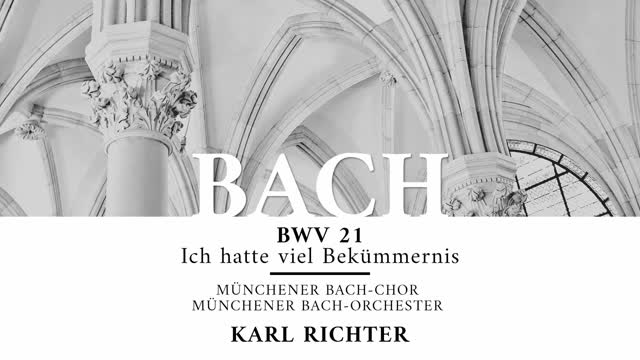Premium Only Content

Cantata BWV 21, Ich hatte viel Bekümmernis - Johann Sebastian Bach "Karl Richter"
🎻 Enjoy the music. Please Follow, like & comment, this is immensely appreciated 🎻
Composition Year: 1713-23
First Performance: 1713-10-08 in Weimar (funeral of Amelia Maria Harreß)
Dedication: 3rd Sunday after Trinity
Performers: Edith Mathis - Sopran • Ernst Haefliger - Alto • Dietrich Fischer-Dieskau - Basso. • Münchener Bach-Chor • Münchener Bach-Orchester • Karl Richter, Dirigent.
Recorded: Munchen, Herkulessaal, 7/1969
Recording quality: High
1. Sinfonia
2. Chorus: Ich hatte viel Bekümmernis in meinem Herzen
3. Aria (Soprano): Seufzer, Tränen, Kummer, Not
4. Recitativo (Tenor): Wie hast du dich, mein Gott
5. Aria (Tenor): Bäche von gesalznen Zähren
6. Chorus: Was betrübst du dich, meine Seele
7. Recitativo (Soprano, Bass): Ach Jesu, meine Ruh
8. Aria (Duet, Soprano, Bass): Komm, mein Jesu, und erquicke; Ja, ich komme und erquicke
9. Chorus [+Chorale]: Sei nun wieder zufrieden, meine Seele
10. Aria (Tenor): Erfreue dich, Seele, erfreue dich, Herze
11. Chorus: Das Lamm, das erwürget ist
Work:
Johann Sebastian Bach composed the church cantata Ich hatte viel Bekümmernis (I had much grief), BWV 21 in Weimar, possibly in 1713, partly even earlier. He used it in 1714 and later for the third Sunday after Trinity of the liturgical year. The work marks a transition between motet style on biblical and hymn text to operatic recitatives and arias on contemporary poetry. Bach catalogued the work as e per ogni tempo (and for all times), indicating that due to its general theme, the cantata is suited for any occasion.
The text is probably written by the court poet Salomon Franck, who includes four biblical quotations from three psalms and from the Book of Revelation, and juxtaposes in one movement biblical text with two stanzas from Georg Neumark's hymn "Wer nur den lieben Gott lässt walten". The cantata possibly began as a work of dialogue and four motets on biblical verses. When Bach performed the cantata again in Leipzig in 1723, it was structured in eleven movements, including an opening sinfonia and additional recitatives and arias. It is divided in two parts to be performed before and after the sermon, and scored for three vocal soloists (soprano, tenor, and bass), a four-part choir, and a Baroque instrumental ensemble of three trumpets, timpani, oboe, strings and continuo.
Bach led a performance in the court chapel of Schloss Weimar on 17 June 1714, known as the Weimar version. He revised the work for performances, possibly in Hamburg and several revivals in Leipzig, adding for the first Leipzig version four trombones playing colla parte.
Extended info of this work: https://bit.ly/3qHPNLc
Extended biography: https://bit.ly/3yfbm90
***
If you have the means and desire to contribute to this channel, you can Buy Me a Tea - https://ko-fi.com/classicalmusicpd
***
ATTRIBUTION:
The music is licensed and attributable to: Achiv Production.
-
 1:12:32
1:12:32
Classical Music P.D.
2 years agoSymphony No.5 - Gustav Mahler 'James Levine - 1977'
185 -
 LIVE
LIVE
Flex011
4 hours ago $0.05 earnedCronos: The New Dawn – Brutal Time-Travel Horror Survival
48 watching -
 33:11
33:11
The Finance Hub
16 hours ago $0.72 earnedBREAKING: JD VANCE JUST RELEASED A MASSIVE BOMBSHELL!!! OMG!!
1.74K8 -
 18:06
18:06
Professor Gerdes Explains 🇺🇦
14 hours agoAfter Major Attack, Trump Vows "Phase II" Sanctions on Russia
3.78K5 -
 LIVE
LIVE
EVASIVE_rabbi
4 hours ago✅️ 2 Dumb Navy Vets & A First Playthrough #Coop ✅️
66 watching -
 LIVE
LIVE
Cook14u
8 hours agoSeahawks Let Me Down, DO NOT Talk About How I Look 🤐🙃🥴
15 watching -
 8:18
8:18
MattMorseTV
15 hours ago $9.28 earned2.2 MILLION in ONE YEAR.
64.4K144 -
 LIVE
LIVE
TheKappaConvict
2 hours agoRainbow Six Siege X Lets send Em Packing Boys | The kappa Convict
11 watching -
 1:05:18
1:05:18
Steve-O's Wild Ride! Podcast
3 days ago $6.89 earnedYUNGBLUD Stands Up For His Generation | Wild Ride #265
67.7K14 -
 12:11
12:11
Nikko Ortiz
2 days agoCrashout 6 Rumble
94.1K9